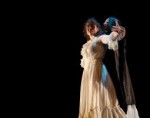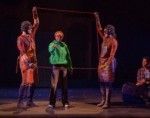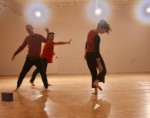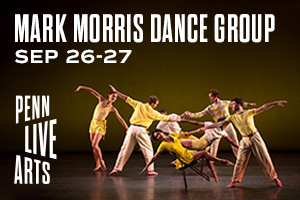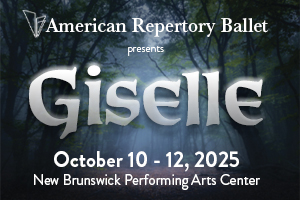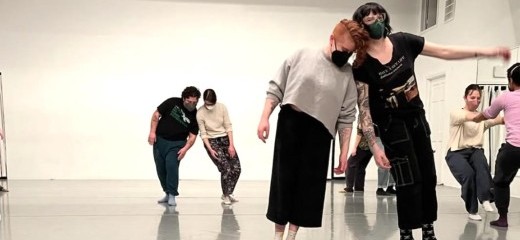
Finding Community, Building Community: An Interview with Philly Dance Share
by Madeline Shuron
“If you were to describe Philly Dance Share in one word, what would it be?"
There’s a widening of eyes, nervous laughter, and a leaning in.
“Just one word?”
“Yeah, or a quick phrase.”
“Okay. Umm…”
A new voice: “I have one: dance.”
Another voice: “Welcoming.”
A third jumps in: “Extended family.”
“This is hyphenated: open-arms.”
“Play.”
“Creativity.”
“Silly.”
“Empowering.”
The group hums in agreement. I’m sitting with members of the aforementioned Philly Dance Share (PDS) in the CHI Movement Arts Center (CHIMAC) in South Philly, chatting about the group’s history, present, and future before an evening class begins. The group–consisting of Britney Johnson, Sarah Messenger, Shosh Isaacs, Vyette Tiya, and Katherine Desimine1 –are just as warm as the lights in the studio, providing comfort against a chilly Thursday night. They are just as excited as I am to talk about how PDS is changing the Philly dance scene through a radical, community-oriented practice.
In December of 2022, Desimine had the urge to take–and teach–more dance classes in Philly. “Well, what if there was some way to share that labor between everyone?” she said, referring to the labor of organizing classes: the money, the time, and the marketing, just to name a few. “I kind of floated [that idea] on Instagram, (...) I think forty people commented on it, being like, ‘this is an amazing idea, we should definitely do this!’” So, with the idea anyone could sign up to teach, Desimine started putting the word out for offerings of weekly classes starting in January of 2023. “People signed up to teach very fast, and then I think very quickly, in February or March, I was like ‘let’s add another day,’ so it was then twice a week.” Classes have, for the most part, been offered at the CHIMAC studio we’re in tonight; the grey marley holding the embodied knowledge of classes that range in genres from contemporary to West African to hip hop to score work to photography popups.
But after about six months of running the group by herself, Desimine was burning out. In a cozy meeting at a local retro vinyl bar, she had planned on handing the group over. “I was basically gonna be like, here you go! Do it, I don’t want to be involved … but everyone was so positive and enthusiastic and just like had amazing ideas for how to continue and grow and be cooperative and collective so no one got burnt out … and by the end of that meeting I was like, ‘I want to be part of this still,’ which I’m very happy about.”
From then on, it’s been going strong. “We [the collective leadership team are] also all volunteers,” says Tiya, “so that relationship of the labor, time, effort, skills; sharing … just comes willingly from all of us.” The group is fully committed to a method of community ethos; that paired with a pay-what-you-can, no-one-turned-away-for-lack-of-funds (PWYC, NOTAFLOF) model allowing people to take classes at varying levels of payment. The money collected goes first towards paying for studio space, then teachers. The leadership team is committed to a non-hierarchical collaboration, as Tiya elaborates: “it’s very much a consensus: folks express if they’re into something, and if they’re not into something, we’ll talk about it–we won’t move forward unless we’re all in agreement with it…and even with the roles we have internally…are very much like ‘who’s available for the next couple of months and how much bandwidth do you have, and we reorganize roles as people are available.” “Your 100% is your 100%,” says Johnson.
So what makes it all work? The community, of course. PDS attributes their success to the grassroots, word-of-mouth marketing that happens naturally through participants being simply excited about the offerings and their experiences. “If you’re not having fun, what’s the point?” asks Messenger. So often nowadays in US contemporary dance spaces, commercialism and capitalism takes root. Classes become spaces for filming and advancing careers – but PDS stresses they are not an audition. Their Saturday class teaching spots are available on a first-come, first-serve basis, and they hold open calls for their series, curated by the collective leadership team.
Tonight, mik phillips and Tor Breen are co-facilitating a course that doubles as creative research. “It’s about preparedness,” says Breen to the group (some of whom are drop-ins, others who have signed up for the full series), “preparedness along many different lines.” In this improvisation-forward class, participants moved through short- and long-form scores of mapping a partner’s body using their own. There’s heads gently cradling heads, rolling across bodies, and open palms pressing down fingers one by one. The room collectively breathes together as they move through their mapping, guided by phillips and Breen, who effortlessly switch off between moving and talking to the group. They rip large squares of butcher paper from a roll and hand out markers, crayons, pencils, encouraging dancers to visualize and two-dimensionalize this three-dimensional experience. As they move further into class, ghost dances become present, the lingering of the map on the mappees body moving through and amongst them. All of these embodied research activities are punctuated by a smooth conversation guided by prompting questions from Breen and phillips. The whole class is a mix of spontaneity, play, and headiness in the most approachable manner.
As for what’s on the horizon for PDS, the group agrees they want to find ways to pay teachers more consistently, as well as admin; they dream of opening the group up to “more than just classes: performances? Intensives? Workshops?” They want to find a permanent home and completely “enrich the community as a whole.” After all: “you’re either looking for the opportunity or you’re creating it.”
More information on PDS can be found at their website, or via their Instagram, @phillydanceshare.
Footnote 1: Philly Dance Share (PDS) collective leadership team is made up of Britney Johnson, Bailey Fleming, Sarah Messenger, Shosh Isaacs, Vyette Tiya, Katherine Desimine, and Mikah BD. Nikolai McKenzie is also a founding member, though not currently active with PDS.
Article Page Image Description: In a bright white room with light grey marley, dancers are clustered to the right side of the image in pairs, sharing weight. Two pairs of dancers are connected at the shoulders, one pair is connected by the hands, and we can see the legs of two hidden dancers standing back-to-back. There is an implication of motion, through shadows, blurred limbs, and raised feet.
Homepage Image Description: Against a grassy, hilly field, six humans are collected in space. Four are standing in a line, two white individuals and two Black individuals, and two white individuals are kneeling facing each other in front of the standing people. They wear an assortment of loose and tight clothing and are all smiling with joy.
By Madeline Shuron
February 7, 2025


